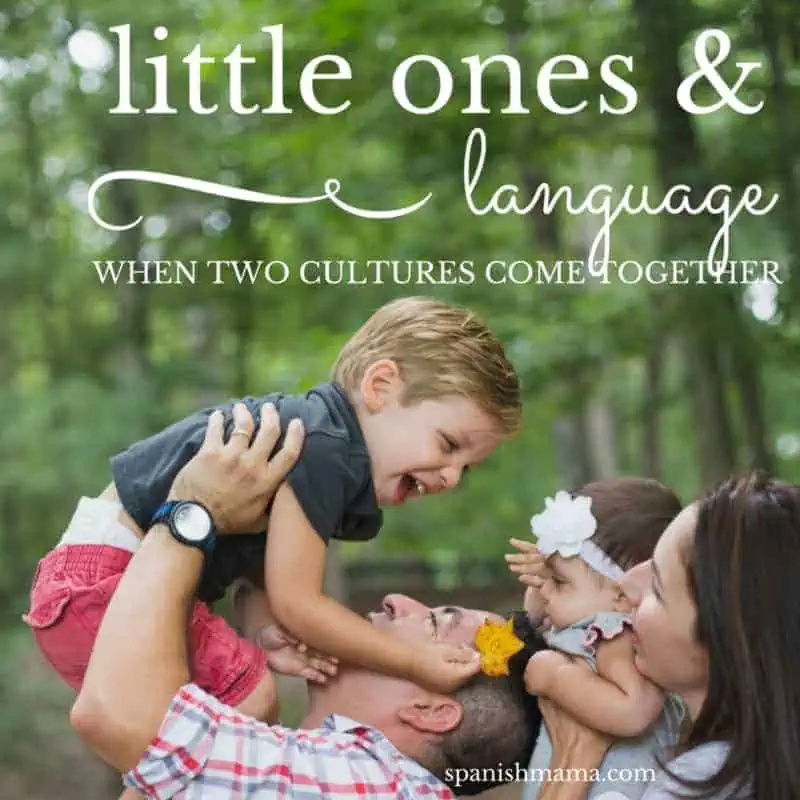Little Ones and Language: When Two Cultures Meet
My two-year-old’s voice comes from the backseat: “Mommy, love you MÁS.”
I peer into the rearview mirror and smile at him. “No, love YOU más.”
“No! Love YOU más!”
This is what the experts refer to as code-switching: mixing language, Spanglish, in our case. I try to avoid it, usually. But here in our van, after a long day of work and apart from each other, I just enjoy the sweet moment, and marvel silently at the way he puts two languages together. Then, laughing, I change to, “No! YO te quiero más!” and we continuing chattering in just Spanish the rest of the way.
As a teacher and a mother, my children’s language process fascinates me. The early days of speaking to my babies in my non-native Spanish– in which I felt self-conscious and weird– eventually gave way to sweet first words, some English, some Spanish. We cheered them on, all of them. Then came the days of Spanglish, a jumble of sentences I hoped would work themselves out. Now my son is two and a half, speaking more complicated sentences, and mixing less. I watch him unconsciously, automatically speak to English with little friends, and change back to Spanish with little sister.
Here’s a summary of how the process has gone so far:
1. Input
Before first words, of course, it’s a lot of input from the parents. We made sure to read lots of little baby books, poetry, and sing songs. I also would narrate things I was doing or things we were seeing in Spanish– “Look, there’s a train passing! What does a train say? It says choo-choo!” This takes some intention, because listening to yourself monologue can get old. But babies are always absorbing. We also did baby sign language, and taught my English-speaking family the signs as well. This way Janio was getting extra integration between the two languages, and it was helpful in getting him to communicate with us before he could vocalize his needs.
2. First Words
I was a little disappointed when Janio’s first words were all English. We had worked SO hard to speak Spanish, after all, even when it felt strange. But we applauded his new words and continued speaking Spanish, and the words in Spanish came, too. He seemed to just learn the word that was easiest out of the two languages. Up, chau, hi, arroz, agua. One of his first words was “hot,” for instance. As he learned more, I would say something like, “Sí, hijo, es muy caliente”– affirming what he’d said, and guiding him back to Spanish. He is a huge train lover, and would gleefully point out everything that slightly resembled a tunnel and yell “tunnel!” in English. I didn’t worry about it, just repeated it back in Spanish, and he figured it out before too long. With my mom he started saying “tunnel,” and with me, “túnel.”
3. Phrases.
Janio started stringing words together at about two, and did a lot of mixing at this point, especially with verbs. He would say, “I quiero agua, Mommy.” For any words that he knew in both languages, though, he innately knew which was Spanish and which was English, and would use it in the appropriate context. Somehow, in little toddler minds, the assumption forms that there are many ways to say something. And incredibly they begin to differentiate which words belong to which language, and who speaks which language around them. It’s just amazing how kids do this. Having a bilingual toddler is so wonderful in finally affirming all your hard work!
4. Sentences
Now at two and a half we are fully into sentences and questions. I have a little backseat driver who hollers at me every intersection, “¡Oh no, ten cuidado! ¡Viene un carro, Mommy! ¡Pare!” He’s got the verbs down now, too. I love it because he uses structures my high school students have to work and work to learn. At this age, books in Spanish are especially helpful because he can follow more complicated stories now.
I’m not sure we’ve done everything right, but I do know that all the investment in forming habits of speaking Spanish at home has been worth it. We sing in Spanish, tickle in Spanish, and kiss goodnight in Spanish. We love each other in Spanish, and that is what a toddler learns best.






